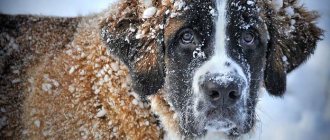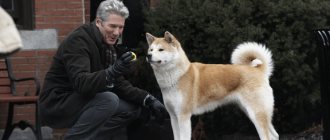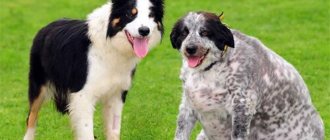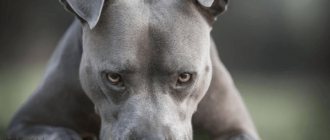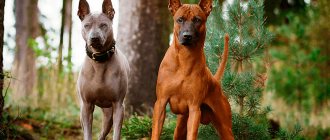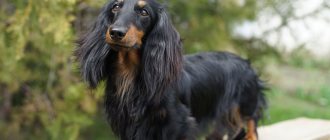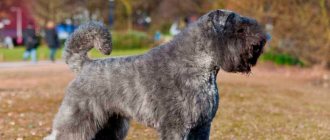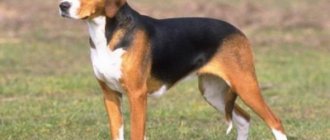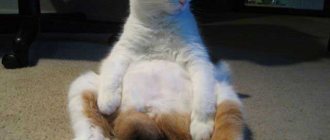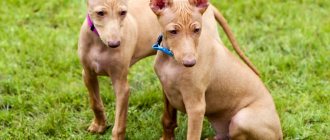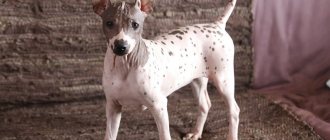For information
The film, made by Americans, amazed many people. Today there is even an expression “Loyal like Hachiko” or “Waiting like Hachiko.” The legendary dog from the film has a real prototype, but it would be more correct to call him Hachiko, because such a nickname is as close as possible to the Japanese language. But still the whole world knows and remembers him under the name Hachiko.
Main features of Akita Inu
To keep your dog healthy and strong, never buy it from an unknown breeder or pet store. Look for an experienced breeder who closely monitors genetic diseases and has a positive track record.
- Akitas are aggressive towards other dogs and are more prone to same-sex aggression.
- Friendly and consistent communication and early training are needed by all puppies. If you show aggression towards them, they often become angry.
- Akita is not suitable for beginners.
- Akitas will chase other pets in the house.
- The presence of severe shedding.
- Prolonged eye contact is a problem for all dogs of this breed as their response can become aggressive.
Training this breed can be challenging and will require a lot of patience, perseverance and experience. It is best to work with a trainer who knows the breed, but it is important to do your own training. Now you know what breed of dog was filmed in the movie Hachiko .
Meet the owner
The real story of the dog Hachiko took place in Japan in the first half of the 20th century. The dog-legend of his and our time was born in 1923, on November 10, in Akita, which is a Japanese prefecture.
A farmer whose dog was whelped decided to give a gift in the form of a puppy to a professor named Hidesaburo Ueno who worked at the University of Tokyo - this is the person for whom the dog never waited. The professor called his new friend “Eighth,” translated as Hachiko. The real story of this dog, which amazed the whole world, began on the day he met his owner.
Every day, like clockwork
From the day they met, man and dog became inseparable. The professor adored his dog, but not as much as the dog adored him. Hachiko was always nearby, except for the time that Hidesaburo Ueno spent at work.
The true story of the faithful dog Hachiko says that the dog followed his owner to Shibuya Station, accompanying him to the city for work. After that, he went home, but at exactly three o’clock in the afternoon he again stood at the station, waiting for his man. This went on day after day.
Character of the breed
The Akita Inu is considered a brave dog with a willful personality that is afraid of strangers but is very loyal to its family. She is alert, intelligent and courageous. Akitas are usually aggressive towards other animals of the same sex. The Akita is ideal for a family with one dog.
In the family, this breed is affectionate and playful. She is considered an eternal companion to the joint activities of the family. She loves to play with toys and various household items. Despite the general opinion that the Akita never barks, in fact it is very noisy, it can grumble, get angry, and bark loudly. Be aware that the Akita's personality can be depressing. This dog is not suitable for beginners or timid owners. She requires firmness and consistency from her owner, who will provide her with the necessary level of discipline. To prevent your dog from getting bored, he will need a lot of exercise and physical activity. Otherwise it can lead to self-destruction. The breed's natural defensive reaction is a tendency to be aggressive. Therefore, training and competent communication of the breed plays a special role from a very early age. This breed is stubborn and you will need a lot of patience to teach it the right manners.
When the owner didn't wait
The real story of Hachiko would not have become known to the whole world if the disaster had not happened. The dog's life changed dramatically on May 21, 1925, when for the first time in his life he did not wait for the professor. No, he didn’t leave, the professor didn’t get off at another station, the man simply disappeared completely! At the university, Hidesaburo Ueno had a heart attack, the doctors could not do anything. On this day, Hachiko became an orphan; at that time the dog was only one and a half years old.
Despite the fact that the dog no longer noticed such a beloved person at the station, he still did not give up hope. Every day Hachiko came to a familiar place and waited, sadly peering into the faces of passers-by.
This behavior of the dog could not go unnoticed. The professor's friends and relatives tried unsuccessfully to place him in their homes, the dog simply ran away and, as before, went to the station, expecting to see his owner. Hachiko waited for the professor until late in the evening, and spent the night on the porch of his house, in which strangers were already living.
Popularity
At the station the dog was fed by railway workers and traders, each of them sympathized with the dog, worried about its fate, but admired such incredible devotion and perseverance.
All of Japan learned the real story of Hachiko only in 1932, when one of the largest newspapers decided to publish an article about the dog and its photo. The publication talked about a dog that is still waiting at the station for its owner, who died seven years ago.
Such a story could not leave a single resident of Japan indifferent; it won the heart of everyone. After the publication of a newspaper with the dog’s story, tourists even from distant cities began to come to Shibuya station just like that. Some just wanted to see Hachiko, some took pictures with him, some really helped - with food and gentle stroking.
Description and history of the breed
The dog breed from the film Hachiko is considered a large and bold dog with a powerful appearance: a large head and small triangular eyes. This is a confident dog with a strong stance. This breed is famous for its devotion to its owners and amazing tenderness towards the family. Imagine a faithful and loving friend, a watchman who will follow you tail, and his goal will be to conquer only you. But at the same time, these dogs will stand aside and remain silent in front of guests. By nature, Akita Inus are afraid of strangers, although they will be friendly to guests as long as their owners are in the house.
Socializing puppies is considered a major part of their training to soften their wariness and suspicion of other people and animals. The Hachiko dog breed is also famous for its habit of grooming itself and licking its body.
The Akita Inu breed was named after the village of Akita in northern Japan where it originated. The first information about Akita dogs appeared in 1600, when they guarded royalty and were used for bird hunting.
Death of Hachiko
The faithful dog spent every day at the station for nine years! During this time, many tried to shelter him, but Hachiko did not recognize a single person as his master and hurried to the station to wait for his only person!
The body of the deceased hero was found near Shibuya Station. As it was established, the cause of the dog’s death was cardiac filaria. The dog was not hungry, this was proven when, during the autopsy of the corpse, several pieces of yakitori were taken out of the stomach - this is a Japanese dish made from the meat and entrails of chicken.
Hachiko died at the age of 11 years and 4 months, of which he had known his owner for only a year and a half, and for the subsequent time he waited unsuccessfully for him at the place of separation. Death took the dog in 1935, on March 8. Until this time, no one had been able to stop the dog’s attempts to come to the station, and not a single person had captured his huge dog’s heart!
The death of the faithful dog caused a real resonance in the country, and the next day was designated as national mourning.
The story of Hachiko - the most loyal dog in the world (7 photos)
If you have watched the movie “Hachiko” and are interested in the story of the famous dog, then this post is for you!
The dog was born on November 10, 1923 in Akita Prefecture (Japan). The farmer on whose farm he was born gave the puppy to Hidesaburo Ueno, a professor at the University of Tokyo, who named the dog “Hachiko” (“eighth”).
photo of real Hachiko
Having matured a little, Hachiko always and everywhere accompanied his master. The professor went to work in the city every day, so the dog accompanied him to Shibuya station in the morning, and at about three o’clock in the afternoon he returned there again to meet his owner.
On May 21, 1925, the professor had a heart attack while he was at the University. Unfortunately, the doctors were unable to save him, so the man never returned home. His dog was 18 months old at that time. That day, Hachiko never waited for his owner, and began to come to the station every day, patiently waiting for him until late in the evening. The dog spent the night on the porch of the professor's house.
Many of Hidesaburo Ueno's friends and relatives tried to tame the dog, taking him home, but he invariably returned to the station to wait for his owner. Railroad workers and local merchants fed the dog, never ceasing to admire his persistence.
After the article “A devoted old dog awaits the return of his master, who died 7 years ago,” was published in a major Tokyo newspaper in 1932, Hachiko became famous throughout Japan. This story captured the hearts and souls of the Japanese. People who wanted to see the devoted dog began to come to Shibuya station.
Hachiko came to the station every day for 9 years, until the day of his death - March 8, 1935 - at the age of 11 years and 4 months. The dog was found dead near the station. He had filariasis and terminal cancer.
Local residents mourn, bending over Hachiko's corpse, saluting his devotion, love and loyalty to his owner. Shibuya Station, Tokyo, March 10, 1935
On April 21, 1934, a year before, a monument was erected to the dog, at the opening of which he was personally present. The death of the dog caused such a wide resonance that mourning was declared in the country in connection with his death.
A tribute to the loyalty and devotion that characterizes the Akita Inu breed, the bronze Hachiko Monument at Shibuya Station is one of Tokyo's main attractions.
A stuffed animal of Hachiko is kept in the National Museum of Nature and Science in Tokyo.
In addition to its charming appearance, the Pomeranian has a cheerful and loyal character. He can play tirelessly all day long, including with children. That's why this baby can become a true friend and member of your family. And you will have photos of relatives and Pomeranian photos on your shelf. So the story about Hachiko may be very sad and about a completely different dog, but in many ways it personifies the devotion and fidelity of our smaller brothers. And the smallest of them - our Pomeranians - do not lag behind the others in anything.
Monument in honor of the legend
The first monument to a dog named Hachiko was erected during his lifetime, almost a year before his death - on April 21, the hero himself was present at the opening of the monument.
The Second World War forced the authorities to remove the monument and melt it down for the needs of the Japanese army. But they didn’t forget about the dog and returned a copy of the monument to its original place in 1947.
The second monument is less known; it was erected in the city of Odate on the station square. Unfortunately, the Second World War took him too for the needs of the army. But again, the copy was installed in 1987.
Today, the monument to the dog Hachiko is not only memories of the dog, but also a tribute to the devotion and loyalty of the Akita Inu breed. Surely it is impossible to find more popular places for appointments than the square where there is a monument to the legendary faithful dog Hachiko, whose real story amazed the whole world with its drama!
Description of the Akita-Inu dog breed
It is known that the main character of the film “Hachiko: The Best Friend” is an Akita Inu dog. Let's try to tell about it.
The Japanese Akita Inu originated on the island of Honshu, and received its name from the name of the Akita province. According to legends, the ancestors of these dogs were Spitz-type breeds crossed with mastiffs. In ancient times, the Akita Inu was a good hunting dog, without which a person could not go hunting. It was Akita dogs that easily defeated any animal: bear, deer, and wild boar.
During the Great Patriotic War of 1941–1945, the Akita breed was destroyed, because only German shepherds were needed for the army. To save the Akita, many owners tried during this period to cross their dogs with the German Shepherd. This is how the modern type of Akita breed turned out.
Today there is a slightly different type of Akita dog, which is officially approved. She was nicknamed the big Japanese dog or the American Akita - Inu. She was bred after the Japanese gave the Akita to Helen Adams Keller, who lived in America.
What does a Japanese Akita Inu dog look like? The appearance features are as follows:
- The coat color can be any, but only natural.
- The coat itself is long, beautiful and silky.
- The height of an adult dog reaches 57–71, but the female will be slightly smaller.
By nature, these dogs are brave, of course, loyal, intelligent and active. They are easy to train, they love children, and will never offend their owner. If the family where they grow up also has pets, then they will be treated with respect. It is believed that Akita dogs are excellent helpers, good companions in any business, intelligent guards and loving and caring nannies.
Most often, dogs of this breed are used in the following areas:
- Police.
- Rescue service.
- Guide for the blind.
The remains are in the museum
The people of Japan were not ready to say goodbye to Hachiko forever, because such a dog no longer exists. Therefore, after the death of the dog, they made a stuffed animal of him, so that descendants could also see him, remember, and not forget the history of this devoted dog.
You can see the real Hachiko at the Tokyo Art Museum. Despite the long history of the story, the flow of tourists to the museum does not stop, and everyone goes there to see that same dog in person.
But the stuffed animal is just a dog’s fur coat. The rest of his remains were cremated and buried. The faithful dog's grave is located in Tokyo at the Aoyama Cemetery in the Minato-ku district.
